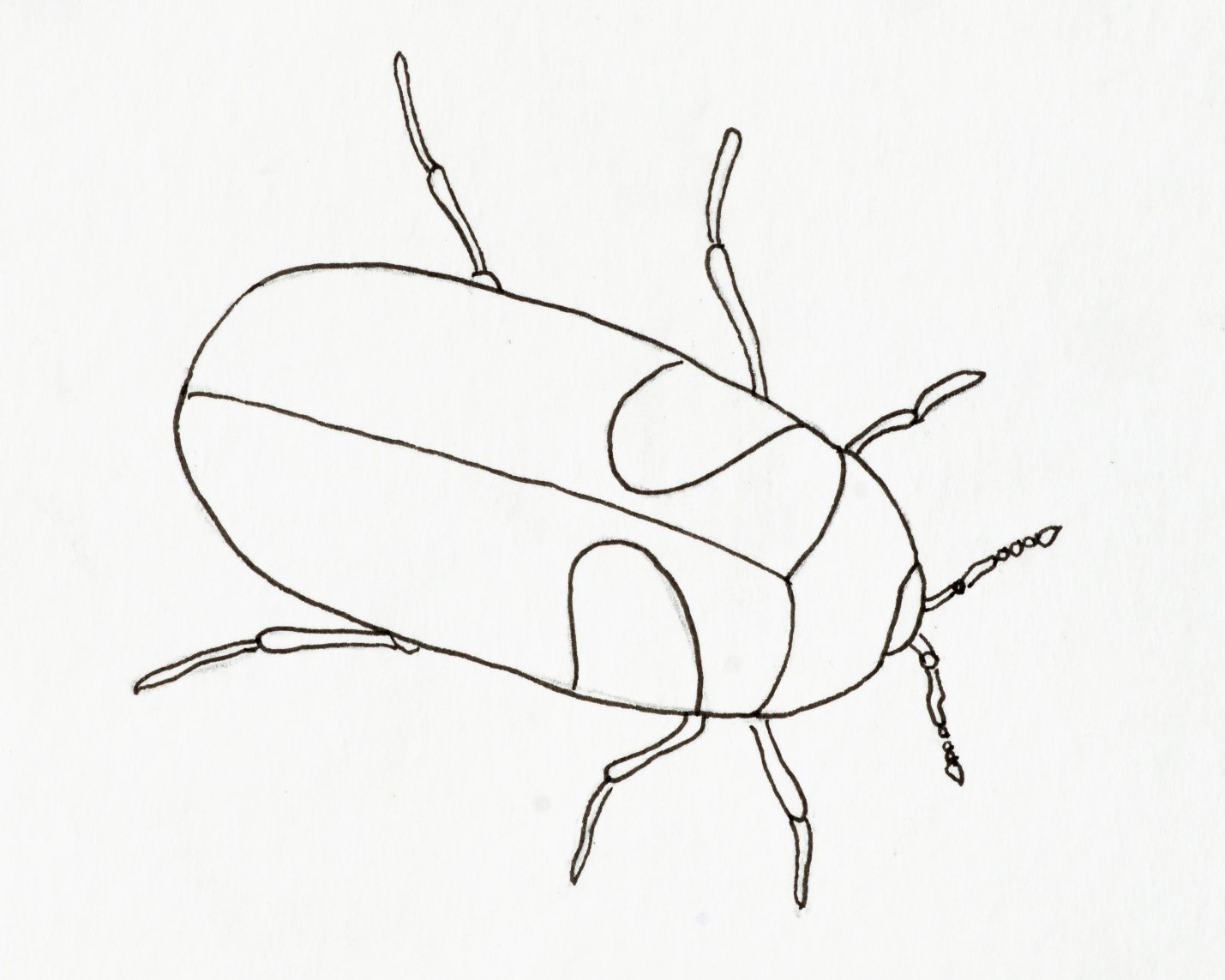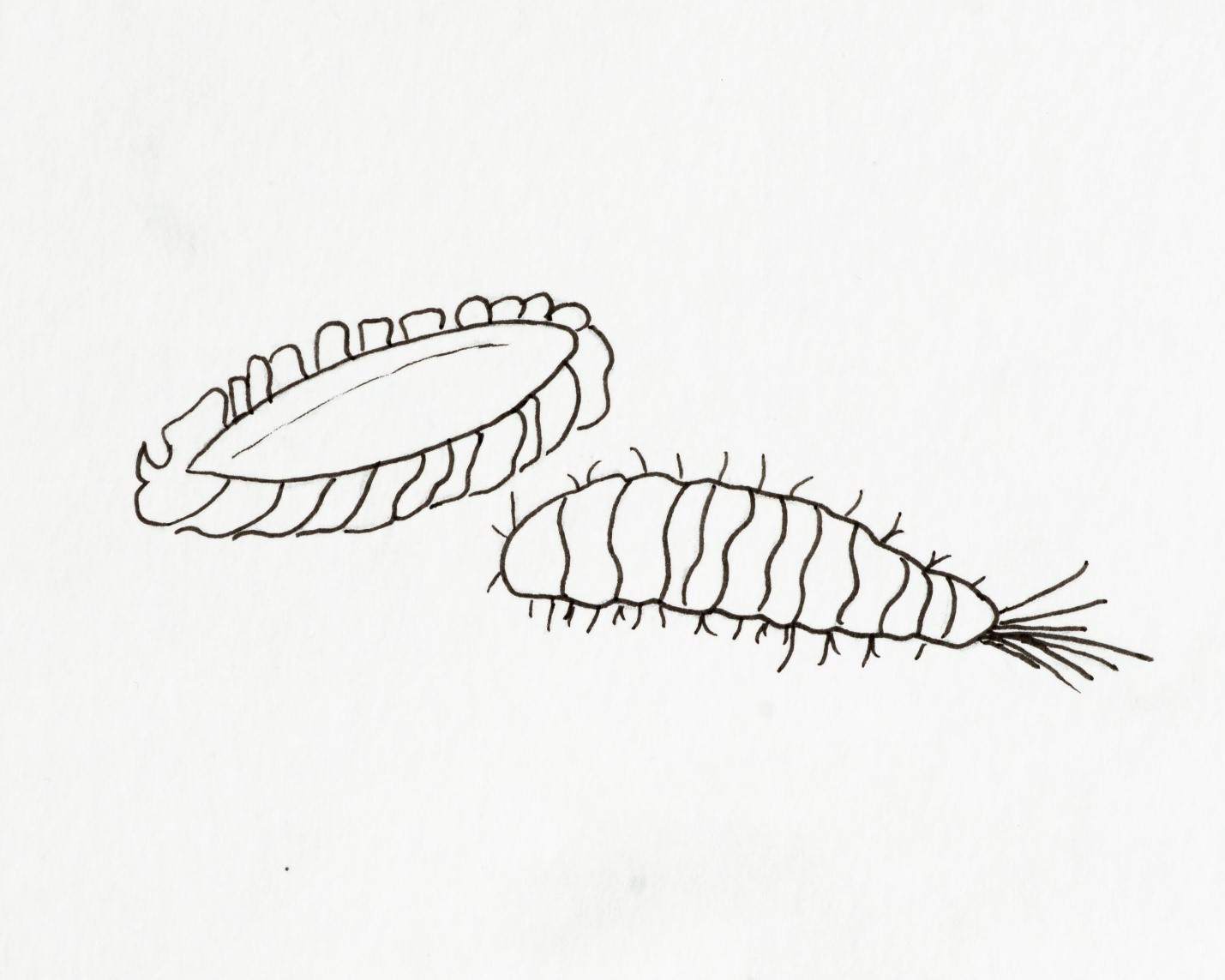Jessica MacLean, the conservator at
Aanischaaukamikw, shares some information about how we keep our collections
safe and free from insect damage.
On a bright spring day in April 2020, 1120 km from Ouje-Bougoumou
amid the COVID-19 pandemic, I found myself sitting at my kitchen table in
Toronto doing watercolour sketches. The subject of which are the bane of my
professional existence – Reesa vespulae.
 |
‘Adult Reesa vespulae’, a portrait in watercolour by Jessica |
In the Linnean classification system that is
used by Entomologists, Reesa is a monotypic genus of beetles in the
family Dermerstidae, meaning the only species in the genus are Reesa
vespulae. Adults are 2.5–4 mm long, with elongated oval bodies. The
hardened forewings of these beetles, the elytra, are brown and have a
yellowish-brown stripe. The small larvae have a hairy appearance, leading to
their colloquial name of “woolly-bears” in museum literature (not to be
confused with caterpillars of the same name). Sometimes referred to as ‘stored grain beetles’ or ‘wasp nest dermestid’, I will be referring this beetle as ‘R.
vespulae’ in this article.
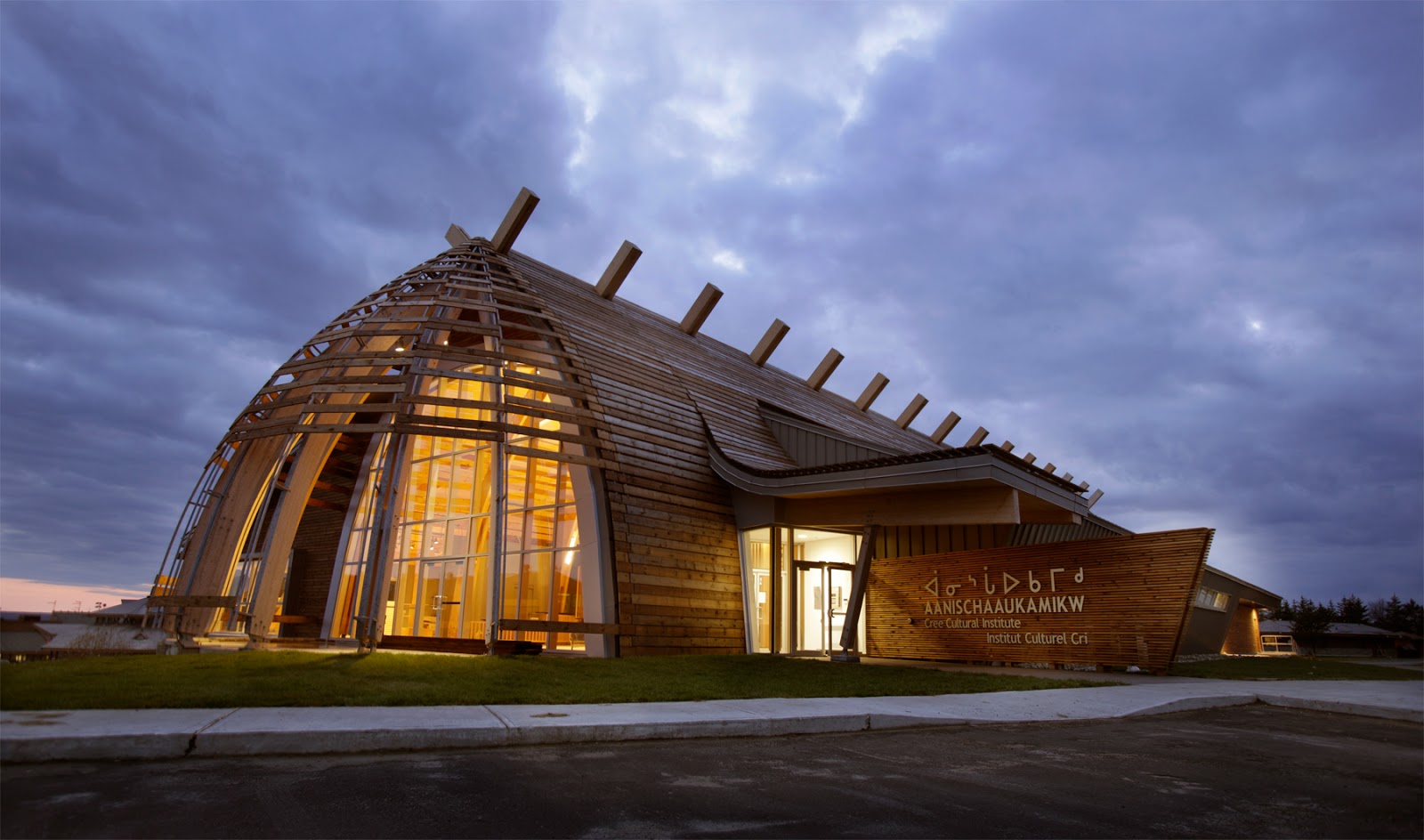 |
Aanischaaukamikw exterior. Photograph: Mitch Linet. |
In my non-pandemic life, I am the conservator at Aanischauukamikw
Cree Cultural Institute and the R. vespulae is my least favourite museum
guest. I have spent the last two years meticulously researching, identifying,
monitoring, and admittedly stressing about a small population of beetles that
are trying to make their home in our beautiful facility.R. vespulaeare a common pest of insect collections, and well known to many
conservators and collections managers. Having worked primarily with Indigenous
collections in Canada, this was the first time I had encountered the species. When
they were first discovered in our building, I was admittedly stumped; these
beetles were simply too small to fit the description of any of the usual
suspects. As I was unable to properly identify the species at first, I looked
at the similarities in appearance and diet to other dermestids and made an
educated guess that these beetles were part of that family. This guess was
supported by the fact that I was able to trap them in baited dermestid lures. R. vespulae are simultaneously my least
favourite part of my job and probably one of the most interesting parts of my
job.
However, in this darkest timeline we are
currently living, I am more than a 12-hour drive south of Ouje-Bougoumou, and
there is nothing I can do about the Integrated Pest Management plan I employ to
keep these unwanted visitors away.
Dermestidae are a family of beetles commonly
referred to as skin beetles and includes a variety of species that are commonly
found in museums such as hide,larder, and cigarettebeetles, all of whom are identified as
pests. I think the title of ‘pest’ that we use in museum preventative care is a
bit of a misnomer, like the word ‘weed’. ‘Weeds’ are a social construct; I’m sure you have
heard the phrase “a weed is a plant in the wrong place.” I think of the R.
vespulae in similar terms. These beetles are neither good nor bad, they are
simply in the wrong place at the wrong time. All organisms, including insects,
have their place within an ecosystem; all of these Nations are our relations.
To assign a negative value to a living thing because it is not wanted by humans
is to disregard the natural order of things and the value we should place on our
interrelations with all things, human, non-human and beyond-human. That said,
as a conservator, my job is to make sure the collections do not become damaged,
in this case – eaten. So, in this instance, these insects are considered
predatory threats.
Dermestidae, R. vespulae among them, are
scavengers, meaning they feed on whatever desiccated animal and plant material
they can find. Luckily for us, R.
vespulae are partial to the carcasses of other insects, which means they
are possibly helping to keep the populations of other, more destructive museum
pests down. Withalittle distance from
the tunnel vision caused by the constant stress of work, I have come to realize
that the R. vespulae are not, in actuality, all that bothersome. They
are actually the least of my worries with the Cultural Institute closed at the
moment. I am far more worried about my colleagues catching COVID-19, floods,
leaks, power cuts, and any number of the other emergency situations that hover
in the back of my mind. Luckily, our Facilities Manager and maintenance staff
are still close by and check the building daily. There are other staff still in
Ouje-Bougoumou who can help out in case any of these admittedly unlikely events
occur.
As a conservator, I am always planning for the
worst possible scenario and strategizing how to minimize any possible risks to
our collections. That is part of what this job is about; knowing how to make a
plan for when things fall apart (physically and/or metaphorically). I am always
trying to think 2 steps ahead of a number of possible disastrous scenarios,
which means I suggest strict guidelines for any plans that involve, or could
impact, our collections. My colleagues
in the field might be able to relate to the self-conscious feeling I have when
trying to communicate the value of following conservation centered ‘rules’ in order
to ensure the collections we care for can be enjoyed into the future.
At Aanischaaukamikw our focus is on Eeyouch /
Eenouch culture, so the majority of our collections are made from materials
sourced from the land. When belongings made of hides, furs, and feathers come
into the building, they are placed in clear resealable plastic bags as part of
our quarantine procedure before they can enter areas where the rest of the
collections are stored.The
museum recieves donations and loans such asmoccasins
that someone has just finished making, hides that have been fixed out at
someone’s camp, or objects that have been sitting in someone’s living room for
decades before coming into our collection. We are not making any judgements
about the use or condition of these belongings when we quarantine them; we
simply have to do this so we can make sure our other collections remain safe.
With the widespread social distancing and isolating we are all engaging in due
to the pandemic, I think now is a good time to cultivate an understanding about
why we perform this essential part of our entry procedure.
In our quarantine area, I place the belongings
inside a resealable bag; gently removing as much air from the bag as possible
without crushing the object; then I let it sit in this designated quarantine
room for two weeks or more weeks. This allows me to check if any insects have
hitched a ride into the building. Some insects will die in the oxygen depleted
environment, others will crawl out into the bag making them easier to spot, but
a thorough examination will be undertaken before anything is moved into spaces
where collections are stored. I closely inspect furs and hides when they come
into the building, including materials that come in to be used for workshops
and craft activities. Dermestids like to graze along the skin and clip the base
of the hairs as they eat; they can do a lot of damage right under your nose if
you don’t catch them in time. Once a pest population takes hold in the
building, it is difficult to stop them from consuming the rest of the organic collections.
If we do see signs of any pests, including droppings (frass) or skin casings
from a previous infestation, we will freeze that item and make sure everything
is dead before bringing it to the conservation lab for cleaning.
 |
Larvae found on bandolier bag |
In
one such case, we found evidence of pests in a pair of bandolier bags that came
in on loan to us. Inquarantine, our previous conservator Fiona
noticed that there were some live larval stageinsects of a type that are sometimes found inside therotting matter ofantlers in this region. The lender was
surprised when notified of this infestation as he lives in a large urban area,
and does not have any rotting animal parts in or around his home. With further
discussion, it was determined that the bandolier bags had been transported in a
duffle bag that was stored for a few days in a closet at a lodge in a hunting
community prior to coming to Aanischaaukamikw. It is entirely possible the
larvae had come from this closet, perhaps a previous guest had left hunting
gear or boots in the same space and this is how the larvae managed to find
their way to the precious beaded bags he brought to us on loan. These are the
realities of life given our location in the non-urban, heavily forested Eeyou
Istchee territory.
 |
| Evidence of pest grazing, tamarack decoy |
Larger
dense objects can be harder to inspect for pests. A few years ago a large
tamarack decoy on a log stand came in on loan. The standard quarantine
procedures were followed before placing the tamarack bird decoy on display with
the rest of our tamarack collection. A short time later, small dark spots were
noticed under the decoy. The floors of our display cases are purposely painted
white for this exact reason; it is easy to spot something that doesn’t belong.
The tamarack was removed and re-inspected in the quarantine area, where it was
determined that the freezing time needed to be increased to reach the dense
insides of this large decoy. It was frozen for a longer-than-usual period,
re-inspected, and placed back on display once it was determined that the pests
were, in fact, dead. The case was closely monitored for renewed signs of pest activity;
however, nothing has been found since.
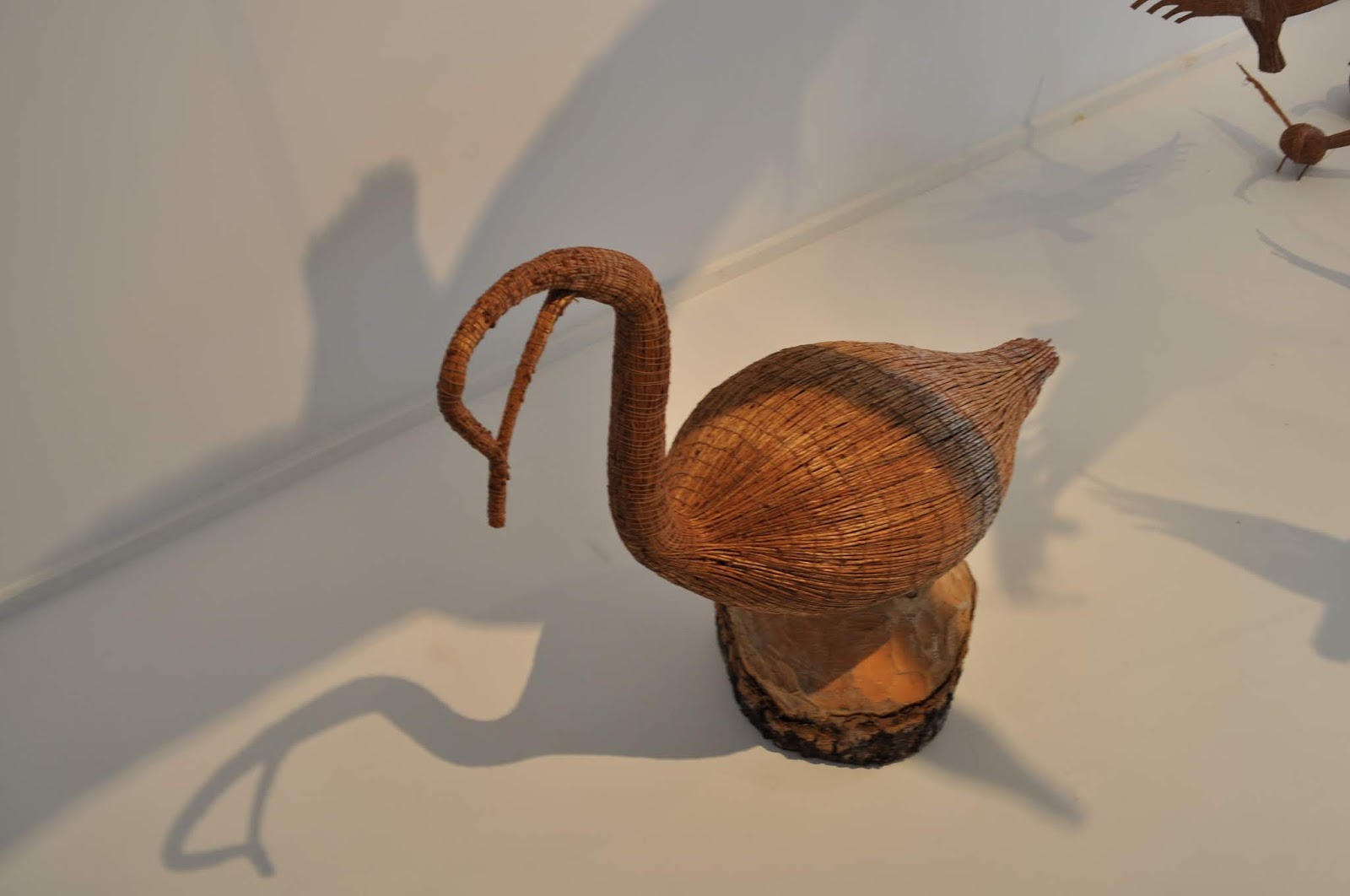 |
| Tamarack decoy on log, on display at Aanischaaukamikw |
Aside from looking for pests in quarantine, we
have pest traps placed throughout the building. Next time you visit a museum,
see if you can spot these traps. Sticky traps are placed in inconspicuous locations around the
building. The purpose of a trap is not necessarily to exterminate the pests,
but rather to collect a sample of the pests in each area in order to identify
those that are particularly dangerous to the collections and monitor their numbers.
The first day of the month is ‘Bug Day’ for me at work. With my logging sheets,
I go around picking up last month’s traps; counting the numbers and types of
pests; and placing a new trap. Traps are placed where the wall meets the floor,
with the opening parallel to the wall, as pests have limited vision and crawl
using the seam as a guide. I add the new data to an on-going graph of pest
populations over time. Currently, our maintenance staff has taken over the task
while I am working outside the community and seem less enthusiastic than I am
about this essential task – maybe this blog will make checking the pest traps
more exciting! I admit, it is tedious and creepy-crawly work, but the information
collected is vital to the safety of our collections, and an important aspect of
good collections stewardship.
Other ways we try to reduce pests inside the
facility include:
·
annual spraying of the
perimeter of the building. This spraying is usually done in May, when it is the
optimal time in the insect life cycle to reduce their numbers.
·
All staff, building tenants,
and visitors remove dirty footwear when they enter. Limiting the amount of dirt
and water tracked into the building helps to make the building less hospitable
for pests; they thrive in dark, moist, dirty places. Staff and building tenants
are encouraged to have indoor footwear to wear when they are inside the
building – added benefit, everyone gets to show off the beautiful moccasins
they wear at work.
·
Food and drinks are only permitted in
designated spaces, where
garbage receptacles are emptied on a daily basis.
 |
| Red Zone – No food or drink is allowed in rooms in the Red zone. |
WhenI first found R. vespulae, it took me some time to correctly
identify them. They were not any of the usual museum pests I had studied.
Though I had found the R. vespulae larvae, ‘woolly-bears’, in sticky
traps in non-collections areas of the building for months, I could not locate
an infestation of adults, meaning the large centralized population of the
insects was undetected. I found approximately 1 adult to every 10 larvae. To
add to the stress of not knowing what these beetles were, and therefore unable
to make a plan to deal with them, the ‘woolly-bears’ shed so rapidly that I
realized individuals stuck to the edge of a pest trap were not necessarily
dead. They could, in fact, free themselves by shedding their casing. These ‘Houdini’ larvae were entirely new to me.
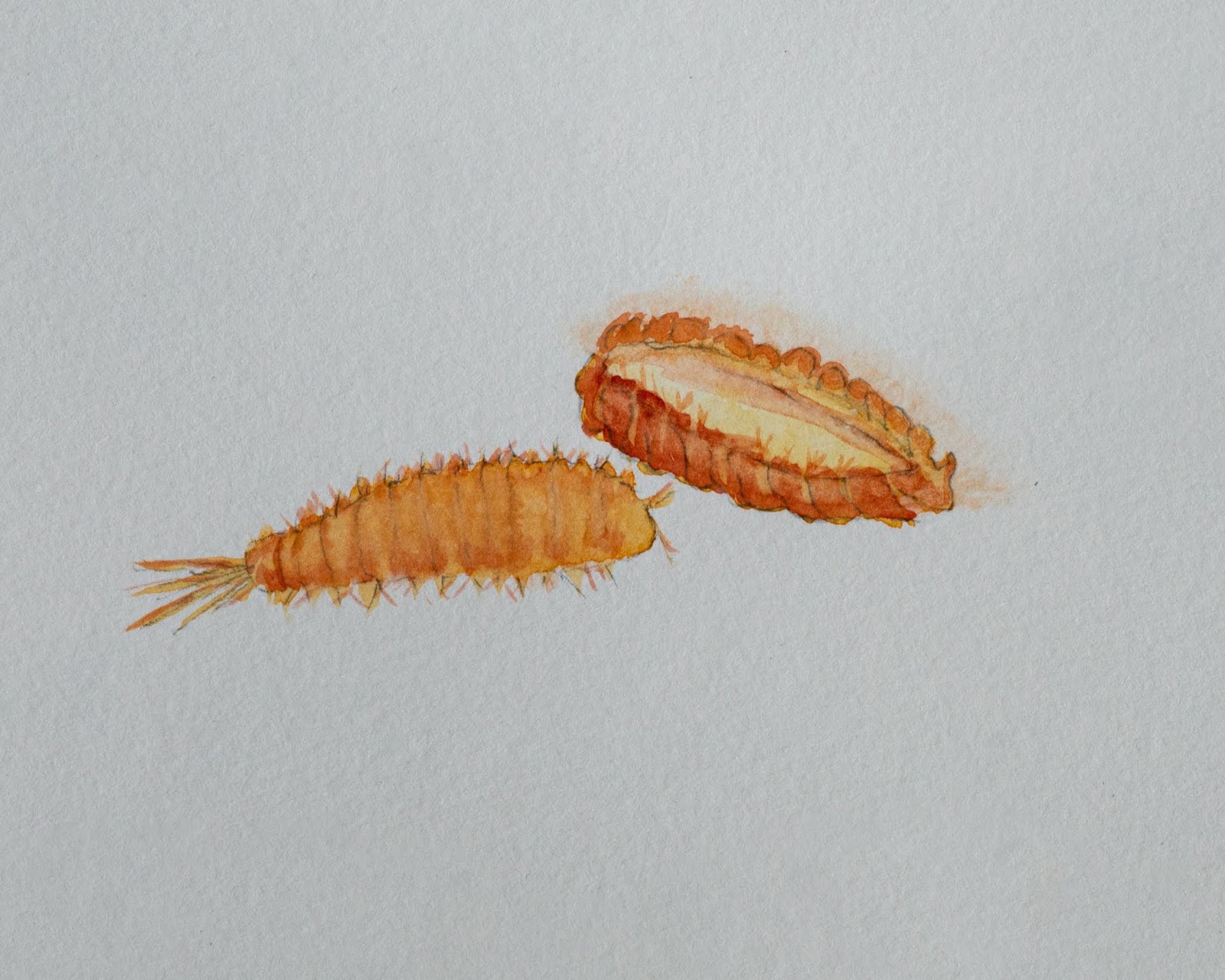 |
| ‘Larvae & casing Reesa vespulae’, a portrait in watercolour by Jessica MacLean, 2020. |
Luckily, we have an amazing environmental
non-profit organisation in our region called FaunENord. They ensure the sustainable development of the Nord-du-Québec by offering
consulting services and developing projects in the areas of integrated land use
planning, to consider the needs of environment, education and ecotourism. One
of their biologists was able to identify these larvae as R. vespulae and
offered some helpful advice. They had a small infestation in their larger
entomologicalspecimencollection a few years back. The R. vespulae apparently
preferred to eat their moths and butterflies, but had also sampled some of their
dragonflies, larger beetles, and bumblebees. FaunENord pointed me towards an
article on the diet and habits of R. vespulae.
In researching these pests, I found that while R.
vespulae are not an ideal pest to host in our facility, there may be some
benefit to having them instead of other species of dermestids. One article
from the Natural History Museum of Dublin described a similarly difficult situation where the local
infestation of these beetles acted as a possibly beneficial factor in helping
to bring a secondary infestation of moths under control. It has been observed,
in some species of dermestids the beetles have been known to attack live moth
larvae. It is now my intention to breed R. vespulae (outside of the
museum), in a controlled environment, to observe their eating habits by
tempting their palates with several of the other common museum pests we have located,
namely psocid and springtails, to test this theory (to the abject horror of our
registrar and other staff who find my intrigue pretty creepy).
The R. vespulae are common pest of entomological
collections due to their ability to eat their way through them like a buffet
lunch, and as such are well known to many collections managers and conservators.
This was my first encounter with the species in a collection of Indigenous belongings
which is why it took me some time to positively identify them. I suspected that
these beetles were part of the dermestid family because of similarities in
appearance and diet, but they just seemed way too small to be the ones usually
found in museums. Our non-urban location and sub-arctic climate means that we
often deal with situations that are different to typical museum conservation
experiences. Finding insects that are less common elsewhere is one example of
our unique situation and demonstrates the type of scenarios I have had to think
about in tailoring an Integrated Pest Management plan that will be effective
for our needs in Eeyou Istchee.
I have included my sketches of the adult R.
vespulae, and larvae with a
casing. Feel free to print them off and colour them in. If you do, make sure to
share a photograph of your creation in the comments on our Facebook page Aanischaaukamikw Cree Cultural Institute, @CreeCulture on twitter
or Instagram – aanischaaukamikw.
Click links to download pdf to colour: Adult R. vespulae Larvae and casing, R. vespulae
